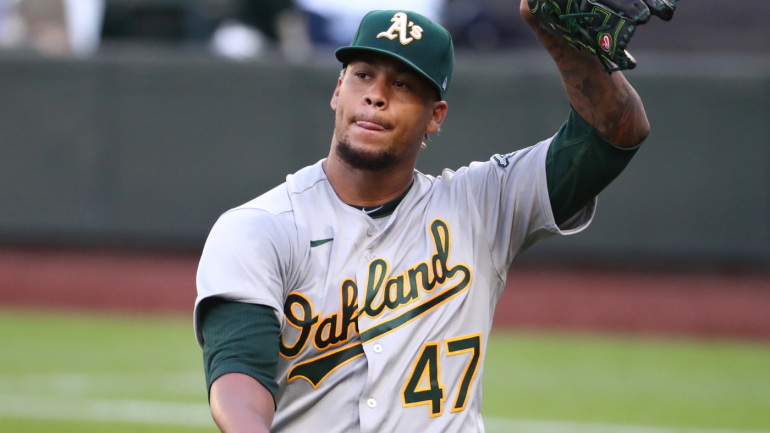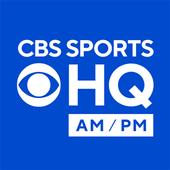
The New York Yankees and Oakland Athletics pulled off a six-player trade on Monday afternoon, just over 24 hours away from Major League Baseball's 2022 trade deadline. The Yankees obtained right-handed starter Frankie Montas and reliever Lou Trivino in exchange for left-handed pitchers JP Sears and Ken Waldichuk, right-hander Luis Medina, and second baseman Cooper Bowman.
The Yankees had already made one pitching acquisition on Monday, adding reliever Scott Effross from the Chicago Cubs. Montas and Trivino will join him in reinforcing a staff that has been impacted by injuries. The A's, for their part, continue a rebuild that started over the winter by adding a package that's loaded with almost-ready arms.
We here at CBS Sports are nothing if not judgmental, and that means offering near-instant analysis on big trades this time of the year. Below, you'll find grades for both the Yankees and the Athletics, along with explanations for those assessments.
With that out of the way, let's begin by recapping the deal:
Yankees receive
- RHP Frankie Montas
- RHP Lou Trivino
Athletics receive
- LHP JP Sears
- LHP Ken Waldichuk
- RHP Luis Medina
- 2B Cooper Bowman
Yankees grade: A
The Yankees, possessors of the best record in the majors, came into the deadline season needing some pitching reinforcements. They've gained as much on Monday by adding Effross and now Montas and Trivino. The Yankees did have to part with three of their top 10 prospects to make those upgrades happen, according to Baseball America, including their fifth- and and ninth-best youngsters in this deal for Montas.
After Luis Castillo was traded to the Seattle Mariners last Friday, Montas stood out as the best starting pitcher available on the market. He's a 29-year-old with an additional season of team control remaining who has tallied a 3.49 ERA (117 ERA+) and a 3.43 strikeout-to-walk ratio in 91 appearances dating back to 2018.
Montas is an unusual starter in the sense that he's all about brute force. His fastball clocks in at 96 mph and the slowest pitch in his arsenal is his 86-mph splitter. That faster, and then even faster approach defies convention, but it works for him. He's able to generate plenty of swinging strikes and swings outside of the strike zone.
Montas does still give some evaluators pause because of his inconsistency. His next start will be his 20th of the year, marking just the second time he's crossed that threshold in a big-league season. (To be fair, he did start 11 times during the pandemic-shortened 2020 campaign.) Montas has fallen short of that number in the past because of suspension and injury, and his recent absence caused by shoulder woes raised eyebrows across the league. He's made two appearances since, and the Yankees (among other teams) evidently felt comfortable with his status.
Montas' additional year of team control is an underrated plus for a Yankees squad that could lose Jameson Taillon to free agency this winter.
Trivino doesn't have as much name-brand appeal as Montas, and his seasonal numbers aren't as pretty. In 39 appearances this season, he amassed a 6.47 ERA, the worst of his career. CBS Sports recently named him as one of the top under-the-radar trade candidates, however, based on the strength of his new sweeping slider and the likely regression of his unsustainable batting average on ground balls.
The Yankees have made a habit out of coaching up reclamation project relievers, including Clay Holmes and Michael King. Don't be surprised if Trivino ends up being the next example of that. He can run his fastball into the mid-to-upper 90s and his aforementioned sweeper has generated a 52 percent whiff rate to date, suggesting that he should prioritize it as his main offering heading forward.
While we noted above that the Yankees had to trade two of their top 10 prospects to net Montas and Trivino, it's worth clarifying that the Yankees have thus far been able to avoid dealing away any of their top position player prospects. It's anyone's guess as to what the Yankees will do the rest of the deadline, if anything, but Cashman has to be pleased that he was able to add these three arms, plus Andrew Benintendi, without parting with Anthony Volpe, Oswald Peraza, or Everson Pereira in the process. Besides, this is a Yankees organization that has proven itself adept at helping pitchers make big gains in a hurry; Monday's trades were just another reminder of that.

CBS Sports HQ Newsletter
Your Ultimate Guide to Every Day in Sports
We bring sports news that matters to your inbox, to help you stay informed and get a winning edge.
Thanks for signing up!
Keep an eye on your inbox.
Sorry!
There was an error processing your subscription.
Athletics grade: C
The Athletics started this rebuild as soon as the owner-imposed lockout was lifted, trading away Matt Olson, Matt Chapman, Chris Bassitt, and Sean Manaea. Montas' departure comes as no surprise to anyone paying attention. The return, however, is difficult to evaluate.
You can argue -- as some evaluators with other teams did -- that it's a quantity-over-quality approach and that the A's should've aimed higher for two in-demand veteran arms, in Montas and Trivino. The players do fit Oakland's ballpark and predilections, though, setting the stage for them to exceed expectations and context-free evaluations. (If our grading system were more sophisticated, we might call this a C that will soon look like a B.)
We'll illustrate the point by focusing on the two main pieces of the payout: Sears and Waldichuk.
Sears, 26, is the only member of the four to see big-league duty. In seven innings he's accumulated a 2.05 ERA (190 ERA+) and a 3.00 strikeout-to-walk ratio. Those numbers don't matter. What matters is that he has a full arsenal and some underlying indicators suggesting he might be able to cut it as a starter.
Sears has an unusually flat release point to the top of the zone, the product of his arm slot, his size, and his ability to get down the mound. He's listed at 5-foot-11, yet he generates six additional inches of extension, or the distance between the pitching rubber and his release point. By covering that ground, he's not only making his fastball play beyond its low-90s velocity, it's also creating a tougher angle.
Sears' fastball doesn't have a ton of vertical break, induced or otherwise, but it does have some of the most extreme run away from right-handed batters in the majors. Indeed, it ranks 11th in that regard, behind new teammates A.J. Puk and Kirby Snead, leading us to think the A's targeted Sears for that reason, among others.
Whereas Sears likely would've been used in a relief capacity with the Yankees, our expectation is that the Athletics will give him an opportunity to start. He seems up to the challenge.
Waldichuk, a 24-year-old, has made 11 Triple-A starts this season. He posted a 3.59 ERA and a 3.04 strikeout-to-walk ratio in those outings, suggesting he's almost ready for the bigs. Depending on who you talk to, Waldichuk either has a good fastball-changeup combination (with two decent breaking balls) or just a good fastball and an arsenal of so-so secondaries.
Whatever the case, Waldichuk has a deceptive delivery that messes with hitters and his own ability to throw strikes alike. He's walked four batters per nine, both this season and throughout his professional career. The A's will presumably work with him on that, but it's unclear how much they can realistically smooth out. He's likely to make his big-league debut sooner than later.
Another interesting aspect of this trade for the A's is how they've continued to target pitchers during this rebuild despite their cavernous ballpark seemingly serving as an in-built advantage in enhancing usable arms. Over the last two seasons alone, the A's have received more mileage than expected from Cole Irvin and Paul Blackburn. It would be overstating things to write that the A's can plug in almost anyone and get some decent innings out of them when they're at home, but you get the gist.
It's clear the A's don't seem to believe that themselves. They've obtained 16 players across their five "rebuild era" trades -- this one, Bassitt, Olson, Chapman, and Manaea -- and 10 of those 16 have been pitchers. Some of that is the nature of how rosters work -- it's easier to find a slot for a pitcher than any other position -- but some of that seems to point toward a concentrated effort to secure arms, and particularly those who will thrive in the Coliseum.
Is that the right call for a team that seems to have an in-built advantage? Or should the A's be focused on adding position players, or other kinds of skill sets who may be more difficult for them to obtain? It's a philosophical question that probably merits its own space.
Medina, 23, is a slight right-hander with a good fastball and breaking ball who has spent the season in Double-A. Although he's started 17 games this season, he's a pure relief prospect for us because of a well-below-average command projection (he's walked more than six batters per nine in his professional career) borne from his delivery's severe arm drag. Medina will be out of options after this season, according to FanGraphs, meaning he'll be a member of the A's bullpen no later than next spring.
Bowman, a fourth-round pick in 2021, is a middle infielder who has primarily played at the keystone this season. Though he's at an age-appropriate level, he's batted only .217/.343/.355 with eight home runs in 364 trips to the plate.


















